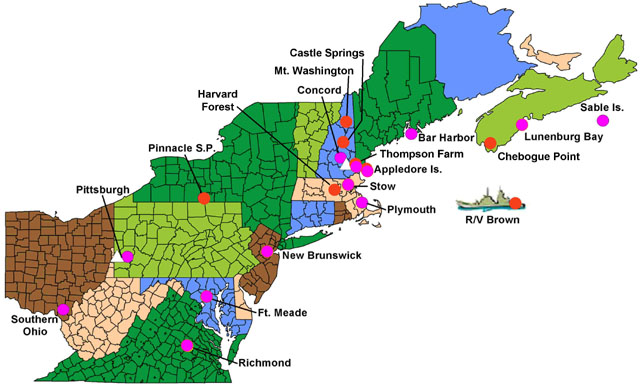Research
Regional Air Quality
Coordinated measurements made by the ICARTT consortium during the 2004 study can help to understand how emissions from local and distant source regions interact to determine the air quality in northeastern United States and the Maritime Provinces of Canada. The mosaic of ozone and aerosol precursor emissions that influences the air quality over a broad region of northeastern North America provides the opportunity to investigate the chemical evolution of individual source categories and their synergism. The coordinated activities possible through the ICARTT consortium will allow two important undertakings that represent breakthroughs in air quality research.
The first undertaking is to connect surface air quality with the important features of transport and chemistry that are occurring above the surface. During the 2004 study, a comprehensive network of surface locations (ground sites and a ship as shown in the figure) will be operating in the region of interest. These surface sites provide a continuous record of the surface air quality on a regional basis. However, the usefulness of the information obtained by surface sites in the past has been limited by the lack of knowledge concerning the structure of the atmosphere above the sites and the influence that this has on surface pollution. The aircraft operated as part of the ICARTT consortium can regularly over-fly selected surface sites to provide horizontal extension and vertical information concerning the meteorology and composition of the atmosphere above these sites. This information will be of invaluable help in evaluating and improving air-quality models and model forecast.

The map above shows the proposed 2004 surface network. Pink circles denote NOAA wind profilers, yellow circles denote cooperative agency wind profilers, red circles denote chemistry sites, and white triangles denote vertically-pointing unattended lidars.
Secondly, the distributed flight coverage provided by the ICARTT consortium during the extended high pressure episodes and subsequent export events offers the possibility of determining the relative importance of local pollution compared to long-range transport in shaping local air-quality. Typically, in the summer, the highest ozone and aerosol concentrations are observed under conditions dominated by regional high-pressure. The most severe of these events are associated with large-scale high-pressure systems that are common in the Northeast during the summer. An individual aircraft will only be able to provide snapshots of these multi-day, large-scale events. The temporal and spatial coordination of the measurement platforms afforded by the ICARTT consortium will provide a more comprehensive coverage that will be invaluable for the understanding these complex regional pollution events.
2004 Implementation Plans:
- Modeling & Forecasting
- Aircraft & Ship Coordination
- Surface Networks
- Measurement Comparison
and Appendix
